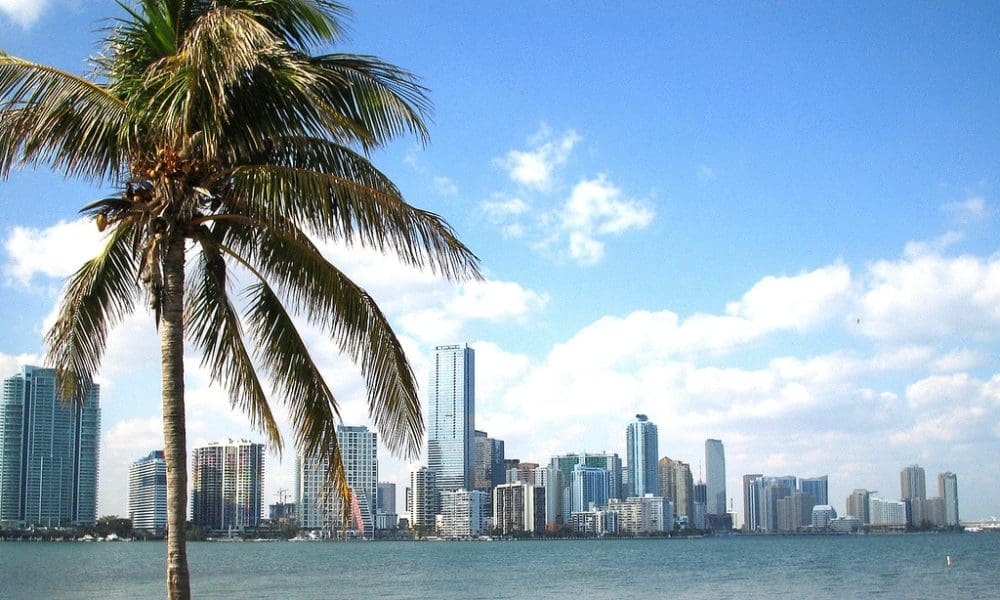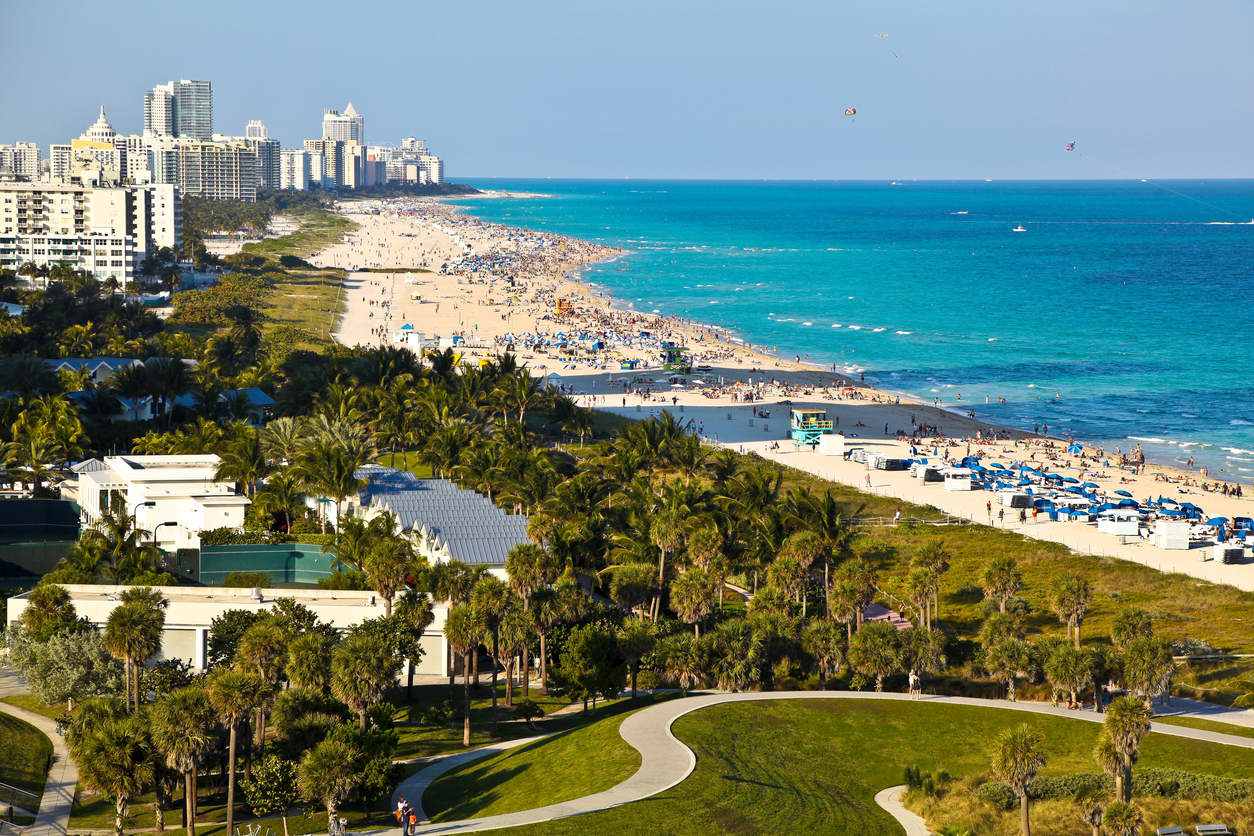Discover five of Miami’s most notable neighborhoods and find the one that fits you.
Miami is lush and green all year round. Although summers are steamy, an ocean breeze pushes temperatures down a few notches, making Miami a great place for windsurfing, cycling, golf, boating and tennis. The city is part of the South Florida region, with Fort Lauderdale to the north and the Florida Keys to the south. To the west, suburbs run from the edge of the city to the Everglades, and the Atlantic Ocean borders Miami to the east.
East
South Beach and its lesser known neighbor, North Beach, have a village feel with its bodegas, boutiques and lots of Art Deco architecture.
Flagship Neighborhood: South Beach
South Beach, also known as “SoBe,” sits on the barrier island between the ocean and downtown on the mainland. It’s a pedestrian friendly locale with the added plus of being low-maintenance since housing consists mostly of condos. You can park your car for the weekend and walk to shops, restaurants, nightclubs, parks and the beach.
South Beach has easy access to the mainland and Interstate 95 with two major bridges. Ocean Drive, which runs along the beach, is the main tourist drag. But locals dominate the area just a few blocks away.
The historic Art Deco district is central to SoBe, while farther north, a few of the classic Miami Modern (or MiMo) hotels dot the landscape. Single-family homes tend to be pricey, but condos can be reasonable, especially as the housing bubble has deflated.
The Neighbors: Young professionals, childless couples and celebrities
Also Consider: North Beach is more popular with families and people who want something a little quieter at night.
West
Coral Gables and Little Gables is where old Miami money meets the nouveau riche with some of the most expensive homes and best schools in the area.
Flagship Neighborhood: Coral Gables
At the heart of Coral Gables stands the venerable Biltmore Hotel, with gracious, Spanish-style architecture that so many people identify with South Florida. Miracle Mile, a shopping-and-eating street, forms the center of the small commercial district boasting a lively happy hour crowd, good local restaurants and high-end boutiques. The streets of Coral Gables are lined with tree canopies, lush landscaping and charming 1920s stucco homes with tile roofs, archways and private courtyards.
Coral Gables is located close to highways and is a quick drive to the beach. While many homes qualify as estates in “the Gables,” smaller, less-expensive houses and some condos are also available and sought-after due to the good schools and Old World ambiance.
The Neighbors: Multigenerational Miami families and deep-pocketed new arrivals from Latin America make up the majority of Coral Gables residents.
Also Consider: Little Gables, just north of Coral Gables, has most of the amenities with smaller homes and relatively lower prices.
South
Coconut Grove and Brickell Village, where the Miami skyline is close but not too close.
Flagship Neighborhood: Coconut Grove
Coconut Grove was once a funky 1960s haven for hippies and drifters. Although it’s now home to many modern homes and large estates, the neighborhood still maintains vestiges of its freewheeling roots.
The marina at Dinner Key is central to the boating community. The Pan Am building on the waterfront, where the now-defunct airline’s former headquarters used to be, now serves as Miami City Hall.
Home to a small, bustling commercial center with boutiques, juice bars and cafes, “The Grove” features winding roads and bike paths, leading to popular bay front parks and sailing marinas. Much of Coconut Gove runs close to the waterfront, and homes tend to be pricey. Condos are generally cost less, but some are top-of-the-line as well.
The Neighbors: Coconut Grove has a broad mix of younger families, older empty-nesters and singles.
Also Consider: Brickell Village is north of the Grove, but is still on the south banks of the Miami River. Thousands of new apartments, condos and townhouses offer a low-maintenance urban lifestyle.
North
Aventura and North Miami Beach offer newer construction with breathtaking views of the Intracoastal Waterway and the ocean.
Flagship neighborhood: Aventura
Gleaming, modern high-rise condos line the coastline. A community anchored around a popular, high-end shopping mall, Aventura features easy access to the highways and is just as close to Fort Lauderdale as it is to downtown Miami.
If you want condo life, boating and tennis plus easy access both north and south, this is a good location. Many condos offer valet parking and private facilities. Mid-range chain restaurants dot the area along with more luxurious offerings.
The Neighbors: Older generations make up the majority of the winter residents, also known as “snowbirds.” Aventura is popular with young professionals and Latin American investors as well.
Also Consider: Sunny Isles
City Center
Home to the region’s central business district and many cultural and tourist attractions, Downtown and the Upper East Side neighborhoods make up the city’s urban core.
Flagship Neighborhood: Downtown Miami
Newly constructed lofts and high-rise condos give way quickly to well-established single-family residential neighborhoods, all with shopping and restaurants nearby. An added bonus is the short commute to downtown offices, the airport and the beaches, which also connect to downtown via two neon-lit causeways.
Downtown isn’t fully redeveloped, but lofts and condos are spawning new mini-neighborhoods in what used to be derelict areas. Wine bars, sushi restaurants, high-end gyms and yoga centers have developed near new condos. The second-Saturday gallery walk in Wynwood and top-notch restaurants along Biscayne Boulevard are luring new residents to the area.
The downtown condo glut is creating excellent rental and investment opportunities for first-time homebuyers. The older, mostly gated neighborhoods east of Biscayne Boulevard have also fallen from their top-dollar prices and are now more affordable. Plenty of fixer-upper opportunities remain for the DIY crowd.
The Neighbors: Downtown is a trend for younger families both gay and straight.
Also Consider: Wynwood, the Design District, Buena Vista East and Miami Shores
SOURCE

